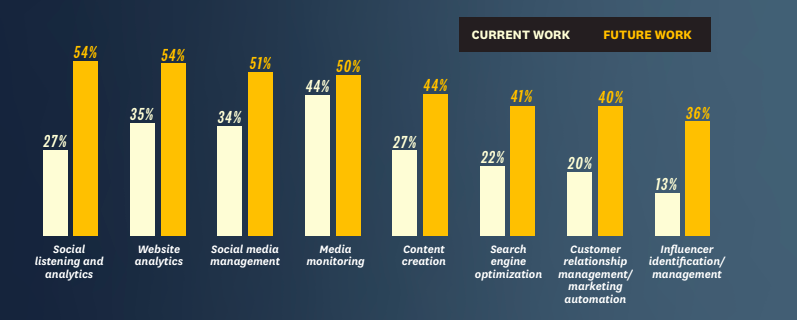Technology is accelerating at a pace so fast, few can keep up. In our day-to-day lives, technology has completely changed how we communicate, how we capture photos and video and how we consume media.

On the marketing/comms side, it’s no different. Technology has completely changed the way to perform many day-to-day tasks at work. Measuring results. Capturing and developing content. And, sharing content. Just to name a few.
But, with that rush of technology has come problems. Sure, technology has made our professional lives easier and more productive and efficient in many ways. But, it’s also made our lives much more complicated and difficult, too.
What am I talking about?
Think about the technologies you use in your job in marketing or comms. Typically, it will look something like this:
- Google Analytics (measurement)
- Spredfast (social media management and listening)
- Canva (content creation)
- Cision (media monitoring)
- Onalytica (influencer management)
- Salesforce (lead management)
That’s just the tip of the iceberg. Many large companies have tech stacks much larger than this. And it’s presenting all sorts of problems–and marketers and communicators know it!
Just look at this survey data from a recent USC-Annenberg study:

Looks to me like 58% of in-house communicators think they’re not doing a great job of leveraging technology. 46% of execs think the same thing! That’s not good, people. Not for the price tag that comes along with these tools. Add up the costs of the tech stack above and you’re probably easily looking at an annual spend of $75,000-100,000–easy.
What’s more, look at all the ground we’re now trying to cover with inefficient technologies. Again, the USC report highlights a disturbing trend:

These are all big areas of work within any comms team that are now relying heavily on technology. Too heavily on technology, if you ask this consultant.
I see three big issues forcing these problems right now:
Technology is being purchased by people who don’t fully understand it.
This is probably the number-one problem. Because technology accelerated so fast, and so many tools are available, shopping for a new social media management platform, for example, can be confusing. Especially since many of these digital and social jobs didn’t even exist 10 years ago! What’s more, people under the age of 30 are typically filling many of these roles. These people are being put in spots to buy technology they don’t fully understand because they simply haven’t been in the workplace and business world long enough. It’s a tough spot and situation, and I see it play out all too often.
Technology isn’t being used to its full capabilities.
Once a new technology is purchased by a comms team, many of its capabilities aren’t being used. Here’s what I believe typically happens–a team will buy a new tool to solve one particular problem (again, let’s say, social media management). The tool solves that problem, but during the shopping process, the vendor lauds all sorts of additional features and functionality that sound fantastic! Look at all these new features we could use! Look at what we could do with all this technology! Except, that never happens. You solve the one problem you sought out to solve, but you end up missing out on the full scope of what the technology could help you accomplish–mostly because people in these roles simply don’t have the time.
Technology isn’t being used at all!
Worst case scenario right here. A team gets forced into buying a tool it doesn’t want. Believe me, it happens. You could be forced to buy by a CMO who is buddies with the CMO at Sprinklr. Or, forced to buy by an IT leader who needs your team to use a certain tool. It’s not as uncommon as you might think. And, when it happens, the comms team might make an initial effort to use the tool. But, over time, that fake enthusiasm quickly wanes. And, the tool starts to collect dust. It sits for months (even years, in some cases), barely used or not used at all. A complete waste of time and money.
So, what can we do to avoid these problems? For one, get smarter about technology. Read up. Attend conferences. Stay current because this stuff is changing FAST.
But, more importantly, resist the urge to see technology as a quick fix for every problem you have. I see it more and more each day. Many times, you simply don’t need the technology. Many times, your team can do the work a certain tool is promising to do with just a little extra effort. And with tech stacks getting bigger by the month, that might not be such a bad thing.

0 Comments